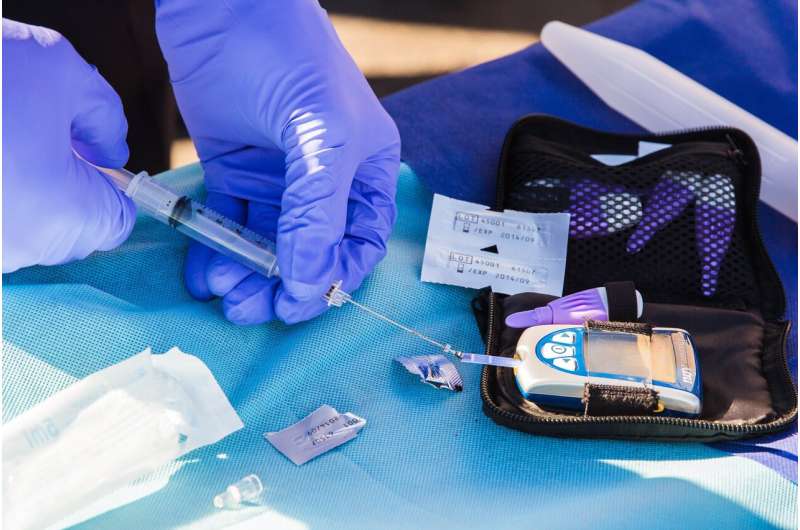This article has been reviewed according to Science X's editorial process and policies. Editors have highlighted the following attributes while ensuring the content's credibility:
fact-checked
trusted source
written by researcher(s)
proofread
1 million people in England may have undiagnosed type 2 diabetes

Around 5 million people in England (about one in nine adults) are on the cusp of developing type 2 diabetes, according to new data from the Office for National Statistics (ONS).
Experts also warn that 1 million people unknowingly already have the condition, most likely older adults. Type 2 diabetes can lead to long-term damage to your body, so an early diagnosis is crucial. Here's what you need to know.
How did the ONS arrive at this figure?
This estimate of people living with diabetes came from the Health Survey for England. This randomly selects people in a way that gets a representative sample of people of different ages, genders, ethnicities and backgrounds.
To estimate the prevalence of diabetes, 26,751 adults were tested out of the population of England, which is around 57 million.
What is type 2 diabetes?
Type 2 diabetes is a long-term condition that affects how the body can deal with glucose (blood sugar).
As a result of genetics and possibly living with a higher body weight, the body becomes less sensitive to the hormone insulin, which normally helps move glucose from the blood into the muscles so it can be stored and used. This leads to insulin resistance, which can persist for decades.
In people who develop type 2 diabetes, their body's ability to make enough insulin to match the resistance and control glucose starts to fail. So there is a combination of insulin resistance and reduced insulin production that results in high blood glucose and the diagnosis of type 2 diabetes.
What does diabetes do to your body if left untreated?
If diabetes is not well managed, it can result in short-term symptoms including increased thirst, a frequent need to pass urine, and even weight loss and blurred vision.
If glucose levels stay high for the longer term, it can affect how nerves work and it can affect blood flow to important organs. This can result in complications including blindness, kidney disease, heart disease, loss of sensation, and foot ulcers.
What are the signs that I might have diabetes?
For many people with type 2 diabetes, there may be no symptoms. Or, if there are symptoms, they can be vague like tiredness or needing to go to the toilet at night.
It is important to look at risk factors that include weight gain (particularly around the middle), having family members with diabetes, being of Asian or African heritage, being male, over 50, and having high blood pressure. Depending on how many of these risk factors you have, your doctor might suggest regular tests to see if you have diabetes or are at risk of developing it.
How will my doctor test for diabetes?
Typically this is by a blood test, most often one called HbA1c. It measures your average blood glucose (sugar) levels for the last two-to-three months.
If you have a level over 48 mmol/mol, it could mean that you have diabetes.
It is also possible to test for diabetes by measuring the glucose level in your blood. If it is above 7mmol/l (fasting) or 11.1 mmol/l (two hours after eating) and you have symptoms of thirst, weight loss and vision changes, your doctor can diagnose diabetes.
Can I buy a test for diabetes that I use at home?
To diagnose diabetes, you need to have a laboratory-grade test. Although you can use glucose machines to test your glucose level, they are not accurate enough to diagnose diabetes.
It is also best to avoid using continuous glucose monitors (as are fashionable right now), as the spikes that these can show after eating might be normal and not a sign of diabetes.
How is diabetes treated?
Type 2 diabetes is treated with diet and exercise, which in some cases can even bring it into remission and normalize blood glucose.
Often it also needs to be treated with drugs, which can vary according to your weight and your blood glucose levels.
Typically people start on metformin, but additional treatments might be needed, which can include injected treatments such as GLP-1 agonists and insulin.
How will my life change if I have diabetes?
Living well with diabetes often follows the same principle of trying to be healthier. It involves eating a healthy and varied diet—and going easy on refined carbohydrates and sugary foods and drinks. It also involves being as active as you can to help your muscles use glucose and remove it from the blood. If appropriate, trying to reduce your body weight can help your body's insulin work better.
Alongside lifestyle changes, having regular health checks (including eye checks) and taking your medication as advised will help to reduce the risk of your diabetes leading to complications.
How can I avoid getting diabetes in the first place?
The best way to reduce the risk of developing diabetes is to have a healthy diet, be active, and manage your weight. A study in the US showed this approach, which helped people at risk of developing type 2 diabetes lose 7% of their body weight, reduced their risk of diabetes by 58%.
This article is republished from The Conversation under a Creative Commons license. Read the original article.![]()




















